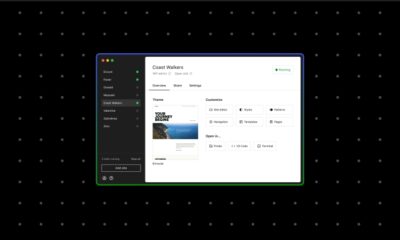MARKETING
5 Open Door Policy Examples

Whether they have an issue they want to be resolved or ideas they think would improve the company or better serve clients, employees just want to be heard.
When you don’t create an open line of communication with your team, they may feel discouraged, leading to poor morale and ultimately lower production. Not to mention that employees who feel undervalued are likely to take their time and talents elsewhere.
But an open-door policy can help employees bring fresh ideas to the table and make you aware of small issues before they become major problems that affect everyone. Here’s what an open-door policy entails, how you can create one yourself, and some examples of open-door policies in action.
What is an open-door policy?
An open-door policy is a set workplace rule that encourages employees to discuss any job-related ideas or issues with their immediate supervisors or any senior-level managers that they feel comfortable discussing these topics with.
This workplace standard should foster communication and trust throughout the company, and employees should not have to fear retaliation should they raise issues with the company or their work with any managers. Instead, they should feel heard and supported through an open door policy.
Benefits of an Open Door Policy
There are several benefits to maintaining an open-door policy in the workplace. First, it fosters better communication across the company. It also helps employees speak their minds about workplace issues as soon as possible, which minimizes conflicts.
An open-door policy can help employees feel more supported and valued by management, which boosts morale and ultimately productivity. It may even lower turnover rates.
In one study on employee voice, researchers found that at a national restaurant chain with over 7,500 employees and 335 general managers, turnover decreased by 32% and saved the company $1.6 million per year by allowing employees to voice their concerns.
Why You Need an Open-Door Policy
Without an open-door policy, your team may experience an increase in workplace conflicts if people don’t feel comfortable raising issues sooner rather than later.
Some employees may begin to isolate themselves if they feel they can’t speak to managers about ideas or concerns. Ultimately, these employees may even leave the company in hopes of finding a workplace culture that is more transparent and communicative.
Plus, without an environment that feels open and supportive, you could be missing out on great ideas that improve the company if employees don’t feel that they can share their ideas with you.
How to Set Up an Open-Door Policy
- Add It to the Handbook
- Communicate Expectations
- Set Boundaries
- Actively Listen to Employees
- Address Concerns In a Timely Fashion
When you’re ready to start implementing an open-door policy in your office, follow these five steps to setting up the standard and following it through.
1. Add It to the Handbook
To make your open-door policy official, you want to add it to the company handbook, so employees are able to review the policy at any time. This also adds more accountability for supervisors to follow the policy.
2. Communicate Expectations
If an open-door policy is new to your employees, you should explain what it is, how it works, and what it will look like for your team.
For example, some companies have a pretty literal open-door policy, meaning when a manager’s door is open, employees can pop in to talk. Discuss how the open door policy works, so employees feel comfortable if they need to use it.
3. Set Boundaries
Creating open and direct lines of communication with management is good, but without boundaries, this can also lead to a loss in productivity. Set boundaries that work for you and your team.
Can employees drop by to discuss issues anytime, or should they email you to set up a meeting? Alternatively, you can share times of the day or week that are the best for employees to stop by your office, rather than leaving yourself open all the time, which can prevent you from doing your work.
Also, consider boundaries on discussion topics. Employees should feel comfortable speaking to management if there’s a conflict with another employee, but this shouldn’t become a way for teammates to gossip about one another or undermine co-workers.
4. Actively Listen to Employees
If an employee comes to you with a problem or idea, make sure you are actively listening to the employee. Otherwise, it can come off as if you don’t care. That means stop typing and sending off emails when they are trying to speak to you. Instead, maintain eye contact, ask thoughtful questions, and end the conversation with a recap of what you discussed.
5. Address Concerns In a Timely Fashion
Some workplaces say they have an open-door policy, but when employees voice their concerns, nothing is actually done. Follow through on your open-door policy by addressing issues as soon as possible after an employee comes to you.
Open-Door Policy Examples
Many companies across different sectors have open-door policies for their teams. Here are some top examples of various companies that use open-door policies to boost transparency, communication, and productivity.
1. IBM
IBM, a massive technology company operating in over 170 countries, has had an open-door policy for several years. It allows employees to access higher management to discuss concerns. As an added level of security, IBM also allows employees to speak confidentially and send reports by phone, email, or even snail mail.
In a study on an IBM subsidiary in France, researchers found that the more the open door policy is communicated to employees, the more confident employees feel in the policy, an example that any workplace should consider as they set up their own open-door policy.
2. HP
HP, another major technology company, has a policy that invites employees to raise concerns quickly and opens communication across all levels of the company. As part of its expectations, HP notes that open communication should be part of day-to-day business practices for all employees.
As far as boundaries go, employees should first bring up their concerns within their own chain of command before taking it to the Ethics and Compliance office. Finally, employees should feel comfortable giving or asking for feedback without any fear of retaliation from management or co-workers.
3. Keka
Keka is an HR payroll software company that prides itself on making employees feel safe, inspired, and fulfilled by their job. So it’s no surprise that the organization has its own open-door policy.
For its own policy, Keka uses open doors literally and figuratively, allowing teams to communicate frequently whether in-person or virtually. This company’s policy applies across various levels and departments of the company, so anyone can raise their concerns to any relevant party.
The policy clearly outlines the expectations and boundaries for the policy, including what types of topics, are considered relevant for discussion and how to have the most effective discussion to resolve issues promptly.
4. Saint Louis University
Open door policies are encouraged at higher education institutions, too. At Saint Louis University, the open-door policy is meant to create a more informal conflict-resolution process that is an add-on to other procedures for employee reviews and staff grievances.
The policy notes that employees can bring up questions, suggestions, or concerns, typically to their immediate supervisor, for assistance. If employees do not receive assistance, the policy directs employees to follow the more formal Staff Grievance Policy.
5. Health Information Alliance, Inc.
The Health Information Alliance, Inc. implements an open-door policy designed to foster a positive work environment. In this open-door policy, there are specific issues outlined that are “open-door issues,” including, “disciplinary action, work assignments, interpretation or application of policies and procedures, transfer and nonsupervisory promotions, or other employment issues.”
Other issues, like evaluations or personal conflicts, are notably not included.
This is more of a hybrid open-door policy that also follows a traditional chain of command, where the employee is encouraged to first speak with their direct supervisor. If their complaint is about their supervisor, then they can go up the chain of command to their supervisor’s manager.
Although considered a more informal route of resolving issues, this policy makes an important note that open-door issues should be thoroughly documented in order to best resolve each concern.
Improve Employee Morale and Trust With an Open-Door Policy
The key to any successful relationship is communication, and that certainly applies to workplace employees. If you want your employees to feel supported, supervisors and executives should consider implementing an open-door policy.
With this workplace standard, employees can raise concerns over company procedures, other employees’ conduct, their pay, or any other work-related issues. It also opens the door for employees to share their ideas, which can benefit the entire company by making things run more efficiently or improving productivity.
Source link




















You must be logged in to post a comment Login